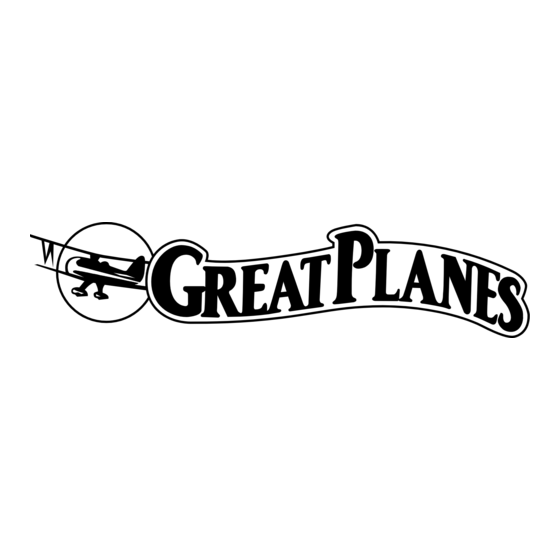GREAT PLANES HeadWind "B" Manual de instruções - Página 12
Procurar online ou descarregar pdf Manual de instruções para Brinquedo GREAT PLANES HeadWind "B". GREAT PLANES HeadWind "B" 16 páginas. Park flyers series

Balance the Model (C.G)
More than any other factor, the C.G. (balance point) can
have the greatest effect on how a model flies, and may
determine whether or not your first flight will be
successful. If you value this model and wish to enjoy it for
many flights, DO NOT OVERLOOK THIS IMPORTANT
PROCEDURE. A model that is not properly balanced will
be unstable and possibly unflyable.
At this stage the model should be in ready-to-fly condition
with all of the systems in place including the motor, landing
gear, and the radio system.
1-3/4"
1. Use a felt-tip pen or 1/8"-wide [3mm] tape to accurately
mark the C.G. on the bottom of the wing on both sides of the
fuselage. The C.G. is located 1-3/4" [45mm] back from
the leading edge of the wing.
This is where your model should balance for your first
flights. Later, you may wish to experiment by shifting the
C.G. through a range of 1-1/2" [38mm] to 2" [51mm] to
change the flying characteristics. Moving the C.G. forward
may improve the smoothness and stability, but it may then
require more speed for takeoff and make it more difficult to
slow for landing. Moving the C.G. aft makes the model
more maneuverable, but could also cause it to become too
difficult for you to control. In any case. start at the location
we recommend and do not at any time balance your model
outside the recommended range.
2. With the wing attached to the fuselage, and all parts of
the model installed (ready to fly), place the model right-side-
up on a Great Planes CG Machine, or lift it right-side-up at
the balance point you marked.
1-3/4"
3. If the tail drops, the model is "tail heavy" and the battery
pack and/or receiver must be shifted forward or weight must
be added to the nose to balance. If the nose drops, the model
is "nose heavy" and the battery pack and/or receiver must be
shifted aft or weight must be added to the tail to balance. If
possible, relocate the battery pack and receiver to minimize
or eliminate any additional ballast required. If additional
weight is required, use Great Planes (GPMQ4485) "stick on"
lead. A good place to add stick-on nose weight is to the
firewall. Begin by placing incrementally increasing amounts
of weight on the bottom of the fuse over the firewall until the
model balances. Once you have determined the amount of
weight required, it can be permanently attached. If required,
tail weight may be added by cutting open the bottom of the
fuse and gluing it permanently inside.
Note: Do not rely upon the adhesive on the back of the lead
weight to permanently hold it in place. Over time, various
factors could cause the weight to fall off. Use #2 sheet metal
screws, RTV silicone or epoxy to permanently hold the
weight in place.
4. IMPORTANT: If you found it necessary to add any
weight, recheck the C.G. after the weight has been installed.
Balance the Model Laterally
1. With the wing level, have an assistant help you lift the
model by the motor propeller shaft and the bottom of the
fuse under the TE of the fin. Do this several times.
2. If one wing always drops when you lift the model, it means
that side is heavy. Balance the airplane by adding weight to the
other wing tip. An airplane that has been laterally balanced
will track better in loops and other maneuvers.
PREFLIGHT
Identify Your Model
No matter if you fly at an AMA sanctioned R/C club site or if
you fly somewhere on your own, you should always have
your name, address, telephone number and AMA number
on or inside your model. It is required at all AMA R/C club
flying sites and AMA sanctioned flying events.
Charge the Batteries
Follow the battery charging instructions that came with your
radio control system to charge the batteries.You should always
charge your transmitter batteries the night before you go flying,
and at other times as recommended by the radio manufacturer.
12
